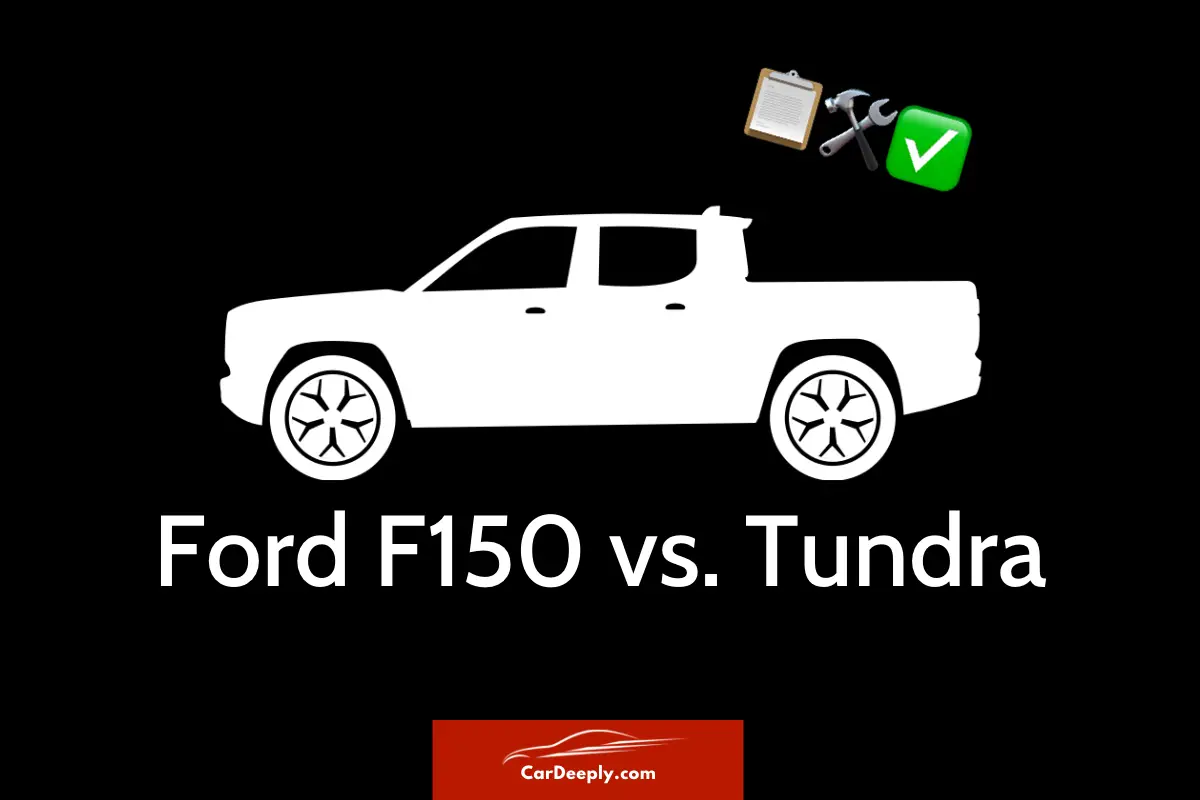If you’re looking for a new, light-duty big truck, you should know the differences between the Ford F-150 and Toyota Tundra.
Both vehicles have great features, and knowing which would fit you best is crucial. Whether you want to buy or simply for information to satisfy your daily car knowledge, you are at the right place.
In this article, you will find a head-to-head comparison of the two great vehicles: F-150 and Tundra. Let’s get started.
Advertising links are marked with *. We receive a small commission on sales, nothing changes for you.
F-150 Vs. Tundra: Key Takeaways
| Ford F-150 | Toyota Tundra | |
| Value & Price | Without the $1,695 destination fee, prices range from $29,990 to $75,835. | Without the $1,695 destination fee, prices range from $35,950 to $73,530. |
| Engine | 290 to 450 horsepower | 358 to 437 horsepower; Tundra is better here because it is available for cheaper. |
| Driving & Handling | Smoother ride, light and slightly numb steering | Twitchy over mild bumps, deteriorates quickly as the pavement gets worse |
| Reliability & Quality | Standard warranty: three years or 36,000 miles.Engine warranty: five years or 60,000 miles | |
| Towing | 2,100 payload capacity; 13,900 pound towing capability with Max Trailering package. | 1,740 payload capacity; 11,120 pounds towing capability. |
F-150 Vs. Tundra: Comparison Of The Two Trucks

In the next couple of paragraphs, we will compare the two vehicles.
Of course, we will break it into several categories, so let’s dig in to determine what distinguishes these two beasts.
Value & Price
Customers looking into the 2022 Ford F-150 will discover it is available in the XL, XLT, Lariat, Tremor, King Ranch, Platinum, Raptor, and Limited trim levels. Without the $1,695 destination fee, prices range from $29,990 to $75,835.
The battery-electric F-150 has a price range of $52,974 to $90,874 for 2022; this excludes the $1,695 destination fee and any federal or state subsidies. The F-150 Lightning is offered in the XLT, Lariat, and Platinum trim levels for retail buyers.
On the other side we have Tundra. Trim levels include SR, SR5, Limited, Platinum, 1794, TRD Pro, and Capstone.
The range of costs, excluding the $1,695 destination fee, is $35,950 to $73,530.
The Tundra line’s off-road variant is the TRD Pro, while the Capstone features luxurious interior appointments comparable to those found in the F-150 Limited. The TRD Pro and Capstone are only available in 4×4; other Tundras let you choose between 2WD and 4WD.
Engine
The Ford F-150’s six engines provide many options without adding much else. The options are as follows:
- 290-horsepower 3.3-liter V-6
- 325-horsepower 2.7-liter twin-turbo V-6
- 400-horsepower 3.5-liter twin-turbo V-6
- 430-horsepower 3.5-liter twin-turbo hybrid V-6
- 400 horsepower 5.0-liter V-8
- 450-horsepower 3.5-liter twin-turbo V-6 (Raptor only)
The twin-turbocharged 3.5-liter V-6 i-FORCE engine powers the Toyota Tundra. It is effective and potent. It can crush it on the job site or the road thanks to its 358 horsepower and 406 pound-feet of torque in the base non-hybrid model.
The other non-hybrid variant tuned differently, produces 479 pound-feet of torque and 389 horsepower.
The hybrid version of the engine, the i-FORCE Max, has a final output of 437 horsepower and 583 pound-feet of torque.
The Toyota Tundra prevails in the engine category because power is available without shelling out a lot of money. Ford’s more potent alternatives are locked behind a price, but the Toyota Tundra makes power easily accessible.
Driving & Handling Experience
One area where Ford outperformed its competitors was in the suspension. The F-150 has a smoother ride than the Tundra, which feels twitchy even over mild bumps.
The ride quality of the Tundra deteriorated significantly more quickly than the F-150 as the pavement got a little worse.
This is somewhat unexpected given the Toyota’s rear coil springs and lower payload rating than Ford’s leaf springs.
The Ford’s steering is light and slightly numb, which is making driving the truck simple, if not very fun. However, it has better steering than the Tundra, which feels clumsier and wanders more on the road.
Both trucks have adaptive cruise control with lane centering, and while the Ford drove itself correctly, the Tundra struggled to keep centered.
Reliability & Quality
In the J.D. Power 2022 Vehicle Dependability Study (VDS), the Ford F-150 comes in third place among Large Light Duty Pickups; however, it does not place among the top light-duty trucks in the J.D. Power 2021 Initial Quality Study (IQS).
As a result, the following roadside assistance and warranty coverage are included with the 2022 Ford F-150:
- Warranty standard: three years or 36,000 miles.
- The warranty on the engine is five years or 60,000 miles.
- 8 years or 100,000 miles for the EV and hybrid system parts guarantee.
- Warranty for hybrid batteries: 8 years or 100,000 miles (10 years or 150,000 miles in jurisdictions requiring California emissions).
- 5 years or 60,000 miles of roadside support.
In the 2022 VDS, the Toyota Tundra is rated as the best Large Light Duty Pickup. In the IQS for 2021, it is also the top-ranked big light-duty truck.
The following warranties and coverage for roadside assistance are included with the 2022 Toyota Tundra:
- Warranty standard: three years or 36,000 miles.
- The warranty on the engine is five years or 60,000 miles.
- Warranty for hybrid systems: 8 years or 100,000 miles.
- Warranty for hybrid batteries: 10 years or 150,000 miles.
- 2 years and unrestricted mileage for roadside assistance.
Towing & Hauling
Ford is the undisputed champion in terms of truck capability.
Tundra could tow 11,120 pounds and carry a maximum payload of 1,740 pounds when fully outfitted.
On the other hand, the Ford featured a 2,100-pound payload capacity and a 13,900-pound towing capability with its Max Trailering package.
However, even with a less robust trailer package, the F-150 could still tow 180 pounds more than the Tundra.
Capacity and ability, however, are distinct concepts.
The Tundra performed a decent job of keeping the trailer straight and narrow, but getting the trailer oriented in the proper direction for inexperienced trailer-backers is the true challenge.
When backing up a trailer, Ford’s system (and Ram’s Trailer Reverse Steering) reduces anxiety by 95%; the Toyota, perhaps 50%. Why Toyota didn’t develop a comprehensive trailer-backing solution, nobody knows.
So, in this case, the Ford F-150 has better capacity and ability to tow/haul.
So, now that you have this information, what do you think, which one is better in your opinion?

Luna Meschiari is a full-blooded car nut who is well known to local garages, as each article is meticulously researched and peppered with the latest piece of information. Guess what car she’s driving right now? A RAV4 2021 Hybrid. But her heart also sleeps for pickups like the F-150. Get to know Luna better on the about us page.
Advertising links are marked with *. We receive a small commission on sales, nothing changes for you.
